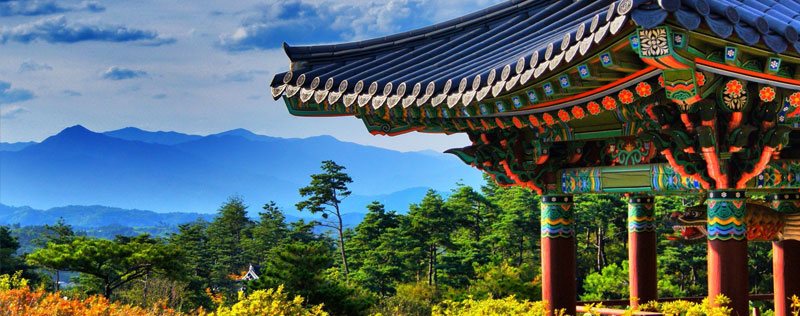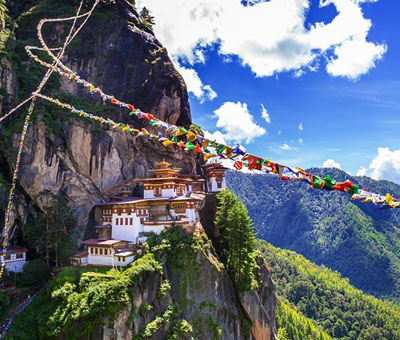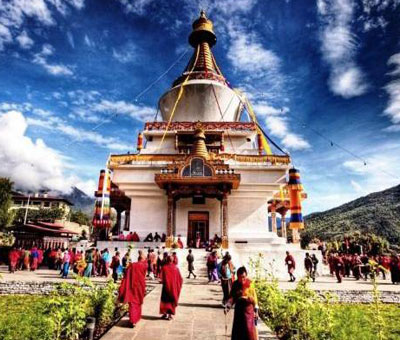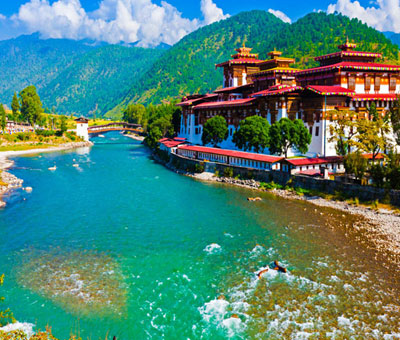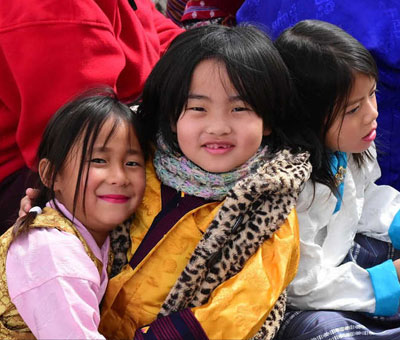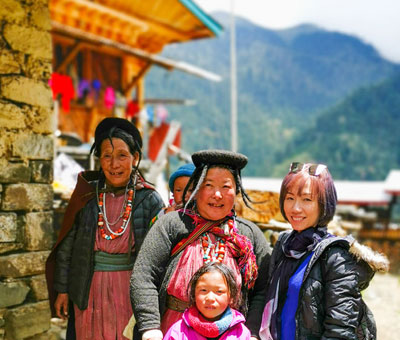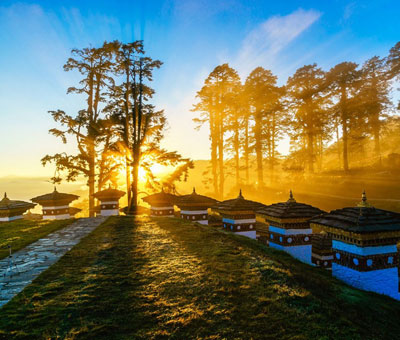Interesting Facts About Bhutan / Bhutan Travel Information
The very name of the Himalayas evokes majesty and grandeur. The nearly impossible terrain and controlled tourism have daunted the most intrepid of travelers. Until now, the beauty of these mountains and the delightful people who inhabit them have lain beneath a veil of mystery. Bhutan itself has, until recent years, been subject to a state of self-imposed isolation, with changes coming only with the present, enlightened government.
Bhutan Tour Packages
Pricing and Itinerary
There is a certain magic about Bhutan , when you visit this tiny kingdom, you become enthralled by the natural beauty, mystical religion, vibrant culture and charming people. Nestled on the slopes of the eastern Himalayas, surrounded by China and India, Bhutan is no bigger than Switzerland and has a population of just 600,000. Bhutan is the only surviving Buddhist kingdom of the Himalayan region. One of the world’s last unspoiled frontiers, Bhutan is truly an exceptional place.
The country of Bhutan indeed presents a modern paradox, a traditional society that is still richly intact and vital. While the basic conservatism of the Bhutanese has enabled them to preserve their past achievements, it has just begun to allow them to accept innovation.
Many historians believe the name Bhutan was derived from the Sanskrit name Bhotanta, which means the end of Tibet. Early British explorers called it Bhotan or Bootan. The Bhutanese refer to their country as Druk Yul, or the Land of the Thunder Dragon. Druk, meaning dragon, comes from the Drukpa school of Tibetan Buddhism. Much of Bhutan’s early history remains a mystery, since many historic documents were lost in fires at the printing works and at Punakha Dzong in 1828 and 1832. In the mid-8th century, Padma Sambhava, who was later called Guru Rimpoche, made his legendary trip from Tibet over the mountains, flying on a tigress’s back. Guru Rimpoche is acknowledged as the founder of the Tibetan Buddhism, now known as Nyingmapa.

Bhutan Map
Many of Bhutan’s notorious ancestors were descendants of the Nyingmapa School. Pema Lingpa, the best-known Nyingmapa saint, died in his home region of Bumthang in 1521. Perna Lingpa was said to be the reincarnation of Guru Rimpoche and the philosopher Longchen Rabjampa. He founded monasteries at Kungzandra, Petsheling, and Tamshing, in the Bumthang Valley.
In 1616 the Gelugs seized control of Tibet’s Ralung Monastery, the religious center of the Drukpa Kagyus, forcing the lamas and their powerful leader, Ngawang Namgyal, to seek refuge in Bhutan. Over the next 35 years, he unified Bhutan and built massive dzongs (fortresses) and monasteries. An astute military leader, Ngawang Namgyal repulsed invading troops from Tibet, assumed the title of Shabdrung Rimpoche—Supreme Religious Power—and proclaimed himself the temporal and spiritual ruler of Bhutan.
With the end of Ngawang Namgyal’s rule in 1651, desparate factions fought for the title of Shabdrung Rimpoche. Though the 1865 Treaty of Sinchula ushered in an era of cooperation between the British and Bhutan, internal fighting led to a new civil war in 1869. In 1884, the British recognized Ugyen Wangchuck as the supreme power. In 1907, he became the first hereditary monarch of Bhutan, and three years later signed a new treaty with the British in which the Bhutanese agreed to British “guidance” in external affairs, and the British agreed to a hands-off policy inside the kingdom.
With Ugyen Wangchuck’s death in 1926, his son Jigme Wangchuck ascended the throne. Jigme instituted numerous reforms—founding schools, repairing monasteries—and concluded a treaty with India, after it gained its independence in 1947. His son, Jigme Dorji Wangchuck, became king in 1952, and set up institutions to preserve the language and culture. Jigme Dorji Wangchuck abolished serfdom, built roads, instituted long-range economic planning, created a comprehensive education system, started the postal system, and brought in trained Doctors. He established the National Assembly, called Tshogdu, thus creating a constitutional monarchy.
After Jigme Dorji’s death in 1972, his son Jigme Wangchuck ascended the Golden Throne. Two years later, the formal coronation took place. When His Majesty became king, he desired, as his father had before him, to open and modernize the country in a cautious maner. This was to be done by developing industry, agriculture, hydro-electricity, and other infrastructure. so that the standard of living could be improved. In addition, the king is committed to maintaining Bhutan’s cultural identity. All new buildings, including private homes, must be made with traditional techniques, and in the late 1980s, a national dress code was established.

Bhutan Royal Family
Until the early 1960s, Bhutan had its back turned to the world. The fabled Land of the Thunder Dragon – country of Buddhists and dzongs, yaks, blue sheep, alpine valleys, and snowcapped peaks—was unknown to foreigners. Bhutan had remained a mystery, untouched by foreign influence. When the kingdom opened its doors to the world for the first time in history, development soon followed.
The southern regions are inhabited mainly by people of Nepalese descent, who immigrated here from the late 19th century until the early 1950s. They are full Bhutanese citizens and have kept their own national dress, language, and Hindu beliefs. Until the late 1980s, recognition was given to the Nepalese regarding their customs, language, festivals, tradition, and dress. However, in 1988, in order to preserve the kingdom’s national identity, the government conducted a nation-wide census aimed at identifying illegal immigrants who could not prove their residence prior to 1958. Numerous ethnic Nepalese lacked proper documentation, and a series of violent acts took place, followed by a mass exodus of Nepali speaking people.
Shortly thereafter, citing the unrest caused by the census results, dissident leaders demanded political changes and more democracy, in order to guarantee respect for human rights in the treatment of Nepalese in Bhutan. Years later, at press time, Bhutan and Nepal still have not completely resolved the situation, and tens of thousands of Nepali speaking persons still remain in refugee camps in southeastern Nepal. However, discussions are taking place between the Royal Government of Bhutan and His Majesty’s Government of Nepal regarding the issue of repatriating these Bhutanese refugees.
Bhutan Cuisine
Bhutanese cuisine is simple, yet tantalizing. It combines a unique blend of spicy hot, Himalayan flavors, with a variety of meats, cheeses, and chilies. The wide use of cheeses really distinguishes the cuisine from that of other Asian countries. Unlike chilies grown in other countries, which are used mostly as a spice those in Bhutan are treated as vegetable in other countries, Considered to be the national dish, ema datsi is made entirely of chilies and served in a creamy cheese sauce.
A delicacy in Bhutan is pork fat, served in large chunks. Hands down, it is the second most popular dish (after ema datsi of course). In addition to pork, preferred meats are yak, beef, and chicken. The Bhutanese particularly like their meats dried, and you will often see strips hanging from lines or in windows. Bhutanese dishes are traditionally served with a massive amount of either white rice or a special red variety grown locally. In fact, it is common for a Bhutanese to consume approximately one kilo (2.2 lb) of rice per day. The Bhutanese often ploy natural foods found in the forests in their cooking. A few of the more widely used products are chanterelle mushrooms, wild asparagus, fiddlehead ferns, bamboo, wild orchids, taro, and dried river weed.

Food in Bhutan
Since a Westerner’s palate is quite different from that of the Bhutanese, many hoteliers have had international culinary professionals train local chefs. When preparing food, there is an emphasis on safety and health standards. Most of the restaurants and hotels in Bhutan serve Indian, Chinese, and Continental foods. However, if you would like to taste Bhutanese food, your chef can prepare it tempered to your liking. During the peak season, most restaurants serve buffet style, and you will find delicious Continental food offered. One final note, except in Thimphu, most of the restaurants are located within hotels.
Here are a few more traditional food items that are found in Bhutan:
datsi—melted, soft fresh cheese
dheysee—saffron-seasoned sweet rice
eze—a salad comprised of chopped chilies, cilantro, soft cheese, onions, and tomatoes
gongdu chum tsoenz—curry prepared with eggs and river weed hontay—buckwheat dumplings filled with cheese and spinach or turnip jangbuli—whole-wheat pasta served with curd and chives
khule—buckwheat pancake
mengey—rectangular rice cake with seeds from the Shar district
momo—flour dumplings filled with meat or cheese and cabbage
nosha pa—beef strips, cooked with radish or dried spinach
paccha tsoem—tender cane shoots, cooked with pork and chilies
phagshapa—pork fat, stewed with radishes or turnips and dried chilies
phinda bjeli namchu—soya bean noodles, stir-fried with mushrooms
puta—buckwheat noodles from Bumthang
shagi menge—cooked rice, kneaded and flattened into thin cakes, topped with black amaranth paste, eggs, and herbs
sha-ngazam—minced beef, fried in ginger sauce, garnished with spring onions
sha-ngazam tsoem—minced beef with peas in ginger-flavored gravy
suja—salted butter tea
tsip—beaten maize
zow—fried rice mixed with sugar and butter
Dzongs in Bhutan
Bhutanese fortresses are known as dzongs and are easily one of the most bewitching aspects of the kingdom. Their classic lines, carefully sloped walls, and finely detailed woodwork make them one of the most exquisite architectural designs in Asia. These impressive, castlelike buildings were constructed in commanding locations, usually on hill-tops overlooking an expansive river valley. Dzongs are located in each of the county’s district headquarters, and house both the administrative offices of the district governments and the monks of the regional monastic communities.
The dzongs were built using ancient construction methods; no architectural plans were drawn, and no nails were used. All are built in a formal pattern, most with a central tower in a courtyard, surrounded by buildings that hold the monks’ quarters and administrative offices.
The Wangdue Phodrang, Thimphu, and Punakha dzongs have two-separate courtyards divided by a central tower. One courtyard is flanked by the administrative sector and the other by the monastic residences.

Bhutan Dzongs
Foreign travelers are forbidden to enter the inner sanctuaries of may temples, monasteries, and dzongs. Exceptions are made during festival val times, when you may enter the dzongs’ courtyards to observe the religious dances. To enter the dzongs at any other time, you need written permission in advance from the Special Commission for Culture Affairs. However, such permission is rarely granted and is only considered for practicing Buddhists. Make your request well in a through your tour operator.
Festivals in Bhutan (Interesting Facts About Bhutan / Bhutan Travel Information)
Many travelers visit Bhutan to observe the religious festivals. These rare mask and sword dances are held annually and are performed in dzongs courtyards, and temples throughout the country. They mark the busiest time of the year, when airplane rickets and hotel rooms are extremely hard to come by. There are many different types of festivals, each having its own spiritual meaning. The most commonly known are the tsechus, dances in honor of Guru Rimpoche, which take place September through December, and in March and June. The dances of the tsechu are performed by monks or lay villagers dressed in brightly color tumes. The dzongs come to life with color, music, and dancing creating a joyous atmosphere.

Bhutan Festival
Shoehorn, Dance of the Four Stags, This dance reenacts Guru Rimpoche’s triumph over the demonic God of the Wind, who created much havoc in the world. After his triumph, Guru Rimpoche rode the stag, which was the mount of the demon. Dancers wear knee-length skirts and makes of horned deer.
Shona, Black Hat Dance, The dancers wear large hats, felt boots and brocade robes, without a mask. Accompanied by drums and the sounds of the dancers’ pounding feet, this dance tells the story of a Tibetan king who once lived in Bhutan and murdered an important lama. A Bhutanese monk killed the king with an arrow concealed in his robe, and thus destroyed the power of evil.
Tungam, Dance of the Terrifying Deities, Dancers wear beautiful brocade robes, boots, and horrific masks. The dance has a very symbolic meaning, and a ritual sacrifice is performed. Dancers representing the power of good encircle the evil demons and capture them in a box. Thus, they not only save the world from the evil spirits, but deliver it to salvation
Pathan’, Dance of the Heroes, The dancers arc dressed in yellow skirts and golden crowns, without a mask. This dance explains how Pema Lingpa arrived at Zangto Pelri and saw Guru Rimpoche in a vision. It is performed to lead believers into the presence of Guru Rimpoche.
Hotels In Bhutan
Throughout Bhutan, hotels, guest houses, and lodges vary in style and quality. All are attractive, built in the traditional Bhutanese architecture.. In Thimphu and Paro, interiors often continue the traditional motif with both carving and painting. Since your visit to Bhutan must be booked through a licensed tour operator, you will be placed in a government-approved hotel. All hotels listed are government approved and are very clean and well maintained. Although many hotels do not have phones in their rooms, all hotels are equipped with telephones fax machines, and international dialing. During the cooler months (Nov. – Feb.) most hotels provide extra blankets and heaters. The traditional heaters, or bukhari, are woodstoves that have rocks piled on top of them to retain the heat. Most hotels have private bathrooms that are reasonably modern, with hot water available at all times.
Many of the guest houses and lodges in Bhutan are family-run operations. This allows you to meet the proprietors and experience Bhutanese culture firsthand. The accommodations range from basic to plush. They usually provide friendly service, spotless (if basic) rooms, and a homely environment. If you are traveling to eastern Bhutan, facilities are more limited.
Many hotels and lodges in Bhutan have traditional hot stone baths. These tublike structures are usually wooden with a metal or wooden chute connected to them. Nearby, a fireplace heats large stones, which, when fully heated, are rolled down the chute into the tub to heat the water. It takes some time to heat the rocks, so let the hotel proprietor know in advance if you would like to take a bath. When the weather is cooler, a hot stone bath may be the perfect end to a great day.
The limited number of rooms in Bhutan can cause a shortage during the busy festival times in September, October, November, February, and March. During these periods, some tourists are relegated to tent accommodations. In the event that you are one of the many in this situation, your tour operator should notify you well in advance. The Bhutanese tour operators strive to ensure that the tents are comfortable and warm—some even provide electricity—and they’ll often compensate for the inconvenience by providing extras, such as special food or dances.
Luxury Hotels in Bhutan
Bhutan has plenty of Luxury hotels , The most popular amongst these are Taj , Meridien and Aman.
10 most popular Bhutan Tour packages
Thimphu Paro Tour
Thimphu Punakha Paro
Bhutan Honeymoon Packages
Best of Bhutan Tour
Bhutan Packages from Delhi
Le Meridien Thimphu Bhutan
Le Meridien Paro Bhutan
Bhutan Luxury Travel Packages
For information on Bhutan holiday packages from India with Air Tickets from Delhi and Mumbai contact Swan Tours, Delhi – one of the leading travel agents in India promoting tourism in Bhutan.
